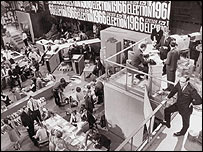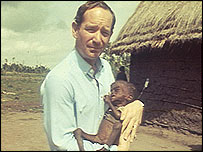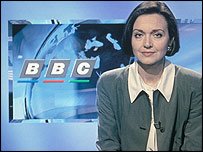|
By Chris Heard
BBC News Online entertainment staff
|

BBC TV News celebrates its 50th birthday on Monday. BBC News Online looks at a news operation which has grown inexorably from relatively modest beginnings.

BBC news correspondents report from around the world
|
The opening bulletin on 5 July 1954 was a 22-minute programme in which presenter Richard Baker was not even seen on screen. Half a century later, the corporation's TV news output is part of the world's largest news broadcasting operation, with more than 2,000 journalists and dozens of newsgathering bureaux.
BBC TV News now transmits 18,000 hours of programming every year, including the BBC One bulletins, Newsnight on BBC Two, and rolling news on the News 24 network.
Here is an outline of how the output has expanded over five decades, using ever-developing technology.
1950s
A BBC news bulletin designed for TV finally arrived on 5 July 1954, amid conflict between the BBC's radio news specialists and the TV division.
The radio team at Broadcasting House insisted on retaining responsibility for editorial policy, including headlines and story content. It was only on those strict terms that they allowed the TV service to handle pictures.

John Snagge was among the BBC's first TV newsreaders
|
The first bulletin from Alexandra Palace in north London consisted of a series of stills (photographs, maps) - with the newsreader heard but not seen - followed by film in the second half. Critics derided the formula, and within weeks Broadcasting House had agreed to faces being seen on screen - but only those of its own radio staff - the first being parliamentary correspondent ER Thompson.
The emergence of Independent Television News (ITN) in September 1955 led the BBC to rethink its outlook as editors faced the challenge of its slick commercial competitor.
A separate TV news department, answerable to director general Ian Jacob, was established as ITN honed its new breed of "newscasters" - journalists in themselves, rather than mere presenters - who included big names such as Robin Day.

A young Michael Aspel was another early recruit
|
Two weeks before the launch of ITV, BBC newsreaders appeared on screen for the first time. The "young team" consisted of Richard Baker, Kenneth Kendall and Robert Dougall in what was recalled as "a daring new departure". A BBC study group later savaged its coverage as "slow, bad, haphazard and inconsistent", while praising ITN's "clearer, more incisive" journalism. This would ultimately lead to a separate TV newsroom with its own editor and reporters, set apart from radio.
The BBC's coverage of the 1956 Suez crisis led to its first notable run-in with the (Conservative) government of the day, which had sought the BBC's total support after UK troops went into action over Egypt's nationalisation of the Suez canal.
The BBC insisted on telling the whole story - of a nation divided - and was accused by Prime Minister Anthony Eden of "giving comfort to the enemy".
The following year saw the launch of Tonight, the first major topical programme to air five times a week, presented by Cliff Michelmore, with a team of reporters including Alan Whicker. The show was praised for its probing style of questioning of those in power.
1960s
The success of the Tonight programme spawned the satirical 1962 BBC show That Was The Week That Was (TW3), the first of its kind to poke fun at public figures in a tone that heralded changing social attitudes on the horizon.
Featuring a young David Frost and produced by key members of the Tonight team, it lasted little more than a year, yet its influence is felt to this day.
By sober contrast, the assassination of US president John F Kennedy in November 1963 was a singularly defining moment in world history covered by BBC TV news crews.

In the 1960s the BBC developed its election coverage
|
Satellites enabled hundreds of millions of people to share the emotions of Kennedy's funeral in front of their TV sets. A significant step for TV news came in 1968 with the introduction of Newsroom on BBC Two, a half-hour bulletin going out at 7.30pm which switched from black-and-white to colour within weeks.
During a momentous year, viewers saw high quality pictures of the Soviet invasion of Czechoslovakia, students rioting in Paris and the Vietnam War. There was detailed coverage of the assassinations of Martin Luther King and Robert Kennedy.
TV news editors faced new considerations about the appropriate amount of footage to air, while presenters and reporters took care to wear light colours to avoid headaches for technicians.
The end of the decade saw unforgettable coverage of man landing on the moon. As operations moved across London from Alexandra Palace to Television Centre, in west London, in 1969, the news magazine Nationwide made its debut in an effort to exploit the BBC's powerful regional network.
1970s
BBC TV's Nine O'Clock News began life on 14 September 1970, broadcast from a studio described in one newspaper as a "polystyrene padded cell".
Newsreader Robert Dougall recalls the desk being too small, and "grey and lavatorial" tiling. But audiences were high and the bulletin would survive for 30 years, making household names of John Humphrys, John Simpson and Michael Buerk.

Newsreaders became TV personalities in their own right
|
In 1975, Angela Rippon became the BBC's first woman news presenter. She later grabbed headlines for dancing on the Morecambe and Wise show - leading to some of the earliest complaints about news becoming part of showbiz.
The 1970s also saw the birth of Ceefax, the system that allowed viewers to see news in text form on their TV sets.
It was launched in September 1974 after engineers discovered "spare" lines at the top of the screen that could be used to transmit words or numbers.
1980s
The start of the 1980s heralded the launch of another new programme, BBC Two's Newsnight, a pioneering combination of news and current affairs.
After a week-long delay in transmissions triggered by union objections, it first aired in January 1980, with presenter Peter Snow announcing: "Good evening - and welcome at last."

Some news reports contained memorable images
|
The programme became synonymous with the forthright interviewing style of presenter Jeremy Paxman, whose repetition of a single question to Michael Howard more than a dozen times (in 1997) has passed into legend. In 1983, at 6.30am on 17 January, Breakfast Time became Britain's first early morning TV news programme, presented by Frank Bough and Selina Scott in a "relaxed" setting typified by red leather sofas and chunky sweaters.
Also featuring Russell Grant, David Icke and "Green Goddess" Diana Moran, there was "no earthly reason why anyone of intelligence should watch it", according to Spectator columnist Richard Ingrams - although 1,500 people rang the BBC to offer congratulations. TV-am launched Good Morning Britain two weeks later.

Anna Ford was among the first female newsreaders
|
BBC One's Six O'Clock News first appeared in September 1984, at the height of the miners' strike and amid a row about alleged bias in the BBC's coverage. Questions were also raised about the presence of cameras contributing to violence on the picket lines. On 27 October 1986, BBC One broadcast its One O'Clock News for the first time.The following year saw upheavals in TV news with the arrival of John Birt from London Weekend Television as deputy director general.
Birt embarked on a policy of radical change, creating specialist reporting teams and introducing a raft of "bi-media" correspondents to work for both TV and radio.
In 1988, Birt strongly condemned a government ban on broadcasters using the voices of anyone representing "organisations associated with terrorism in Northern Ireland".
1990s-2000s
Non-stop news came to the BBC in October 1991 with the launch of the BBC World news channel, aimed at an international TV audience. Originally going out under the name World Service Television, funded by advertising and subscription, it rebranded in its present form as BBC World in 1995, when it became available in 24 million homes.
By the end of 2002 it was reaching more than 200 million homes across 200 countries and territories.

Correspondents file from some of the world's biggest troublespots
|
Back on terrestrial TV, one of the most talked about interviews of all time went out on 20 November 1995 - Martin Bashir's Panorama interview with Princess Diana, seen by nearly 23 million people. Recorded a fortnight earlier in secrecy at Kensington Palace, BBC chairman Marmaduke Hussey was reportedly furious not to learn about it until a week before it went out - after Diana had told the Queen.
Hussey - whose wife was a lady-in-waiting to the Queen - responded with indignation, according to John Birt, who was among a small group who knew what was happening.
With some influential commentators calling for Birt's head, he described events as "the end of the BBC's institutional reverence - though not its respect - for the monarchy".
British TV audiences acquired their own BBC continuous news service on 9 November 1997 with the launch of BBC News 24.
The style of presentation provided a departure from the norm, with younger presenters, jargon-free language and - for the first time - jacketless hosts.
This policy was reversed two years later with a relaunch, as shirtsleeves disappeared and a more formal set was introduced in line with other BBC news output.
Into the new millennium, the revolution of 24-hour rolling news continued apace, providing ongoing challenges for journalists expected to meet a series of deadlines for TV and radio.
In response to a government report in 2002 that was partly critical of News 24, the BBC pledged a "more analytical and international news agenda".
Audiences to News 24 reached an all-time high during the Iraq war, with 23 million watching the service on one day alone when it was also broadcast on BBC One and BBC Two.

